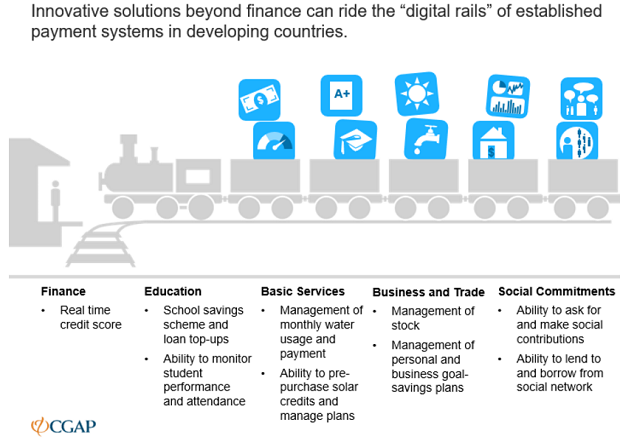Riding the “Rails”: Unlocking Innovation with Open APIs
Every year, Apple holds an annual conference for developers. It is usually here that new devices are introduced. But this year, the event’s underlying theme was openness, and the big announcement was not a new product: It was that developers would now be able to access much sought-after Apple services, including Siri, iMessage and Maps, for purposes of innovation. In other words, Apple is making an effort to allow outside players to create new services that access their platforms, and this news was treated with enthusiasm by developers.
This theme of openness seems to be touching every industry, and digital financial services (DFS) is no different. Today CGAP is releasing a deck that explains the concept of “open APIs” in DFS, how they enable increased innovation, and the role they can play in expanding DFS ecosystems. Below, we provide high-level answers to some important questions digital payments providers might be asking. Those looking for more detail should refer to the slide deck.
1. What are open APIs?
An application programming interface (API) “is an architecture that makes it easy for one application to 'consume' capabilities or data from another application” (Apigee). It is a contract that allows software programs to “talk” to one another, defining what information should be supplied and what actions will be taken when it is executed. A common example is Uber’s use of Google Maps or Waze’s mapping services. Open APIs are widely available for other companies to consume.
2. Why are open APIs important for the financial inclusion ecosystem?
Low-income customers around the world have unmet financial needs extending well beyond payments, such as school savings and loans products, social network borrowing schemes, and financing for durable goods like solar power systems.
For a number of reasons, large digital payment providers are not always best placed to deliver solutions beyond payments that meet these diverse needs. Third-parties (e.g., fintechs, startups, developers, digital banks) — with their more agile development cycles, better knowledge of niche market segments, new technology and lower costs — are often better positioned. However, these players seldom have the required access to digital payment platforms to deliver solutions to market that could benefit providers, third-parties, and poor customers alike.
Useful assets from these platforms, which third-parties could use to build innovative products, include the ability to move money (e.g., bill pay, bulk pay, merchant payments or more advanced payment APIs), data on customers (e.g., transactions histories; agent or customer location), and the ability to garner customer consent.
This is why open APIs are so important. They can connect third-parties to established payments platforms, essentially turning providers’ platforms into “digital rails” that third-parties can leverage to deliver innovative services that address needs of many customers.

3. Why are open APIs important for digital payment providers?
Opening up payment platforms as the digital rails for third-party innovation can create important revenue streams and strategic positioning for digital payment providers.
- Revenue: Providers can grow revenue by increasing revenue per customer, acquiring more customers, and monetizing assets previously unavailable to third-parties. More solutions, more usage, more revenue.
- Strategic positioning: Open APIs can enable providers to strategically position themselves at the center of emerging DFS ecosystems where third-parties will play an important role in the future.
4. How can providers mitigate the risks of open APIs?
Opening APIs can expose providers to risks, including cannibalization of revenue, reputational risk, consumer protection/fraud risk, and internal conflicts. These risks can and have been successfully mitigated by companies in many industries, generating a history of lessons learned and best practices. Of course, DFS-specific adaptations will be necessary. Successful DFS open API demonstration cases will alleviate some of the reluctance to open up APIs beyond basic payment APIs.
5. What is required for this innovative ecosystem to be realized?
CGAP posits that this transition towards openness, and the ability of third-parties to leverage digital payments providers’ (and other) assets, is a critical step in growing the DFS ecosystem, and with it key metrics such as number of active customers, number of transactions per customer and overall industry revenue.
Two things are needed for this shift to be realized:
- Exposure of a greater range of APIs. APIs should facilitate more than just payment solutions, allowing third-parties to effectively access a range of business assets to create solutions — financial and other — that add real value to the lives of customers.
- More openness. This includes the creation of infrastructure and a self-service environment that allows a broader range of third-parties to consume valuable business assets in a safe and effective manner.
The key to this is a mindset shift with the digital payments providers moving from end-to-end customer ownership, to owner/provider of modern “rails” to facilitate industry innovation.




Add new comment